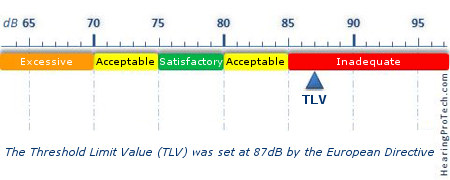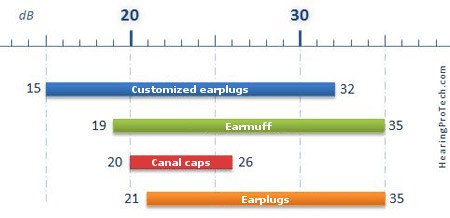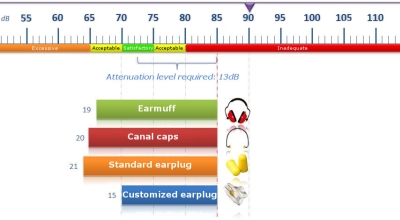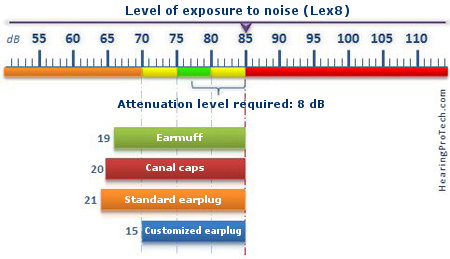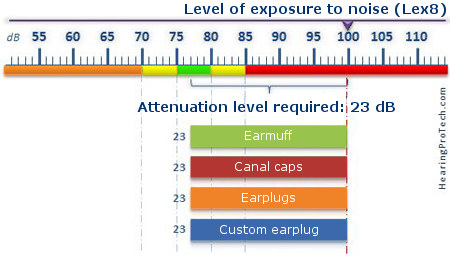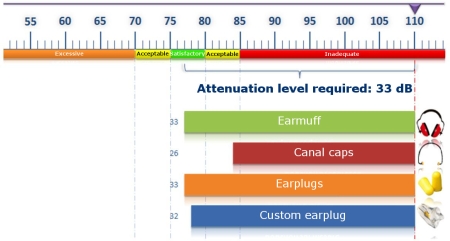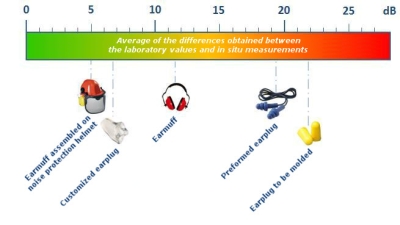There are 5 essential requirements for selecting the correct personal hearing protector: CE marking, suitable sound attenuation, comfort, adapted to the work environment and the nature of work, and awareness of possible medical problems.
Extract from EN458, paragraph 5.1
"Since various existing hearing protectors can be used in a variety of acoustic environments, it is important to choose the most appropriate type of protector. In the selection process, it should take into account all the functions of personal hearing protectors, and also consider the aspects listed below and outlined in the following articles:
- CE marking
- Suitable sound insulation
- Comfort of the wearer
- Work environment and activity
- Medical conditions
The process must be repeated at regular intervals to ensure that effective attenuation is maintained".
1. CE marking
To obtain the CE marking, the hearing protector must meet a number of requirements described in EN352.
The CE approval will be obtained after the "CE test" has been done to verify that the hearing protector meets the requirements of the corresponding EN352 standard. The tests and inspections are carried out by a testing laboratory.
The attenuation data of hearing protectors are obtained after being measured by a testing laboratory, on a panel of 16 trained subjects. The average obtained from the subjects (which is subtracted from the standard deviation to obtain the APV) determines the attenuation of the hearing protector.
The manufacturer therefore ensures that the products made available in the market are strictly identical to the certified model.
It is important to be vigilant and to verify that the manufacturer has the "CE test report" to his name.
2. Suitable sound insulation
In terms of attenuation, many people think that a hearing protector with high attenuation is more effective.
In the case of an employee exposed to high intensities, it is crucial to have sufficient hearing protection, but an employee exposed to low intensities such 85dB (A), will require an attenuation of about 10dB. Providing an HPD that attenuates 30dB is a mistake; an employee who works in isolation cannot wear hearing protection: it would force him to remove them just to hear any signal or the slightest speech.
The objective is to decrease the noise level perceived by the employee to under 80dB (A). The threshold of 77dB(A) of residual noise seems like an acceptable compromise if we refer to the recommendations of the EN458 standard.
Hearing protectors available
A wide number of models are available in the market. In order to look at them more clearly, let's classify HPDs into 4 families:

HPD with ear shells (ear muffs)
Also called earmuffs, headphones, or ear shells, it can either be assembled on an industrial safety helmet or worn independently. It is positioned "around" the ear, and is connected by a hoop or headband passing overhead. It is reusable. It is advisable to change the ear pads (earpiece) every year to ensure effective "blocking" of noise.

Earplugs with hoop/headband
It is worn either at the ear canal or is placed within. The earplugs are connected by a plastic band (hoop) which holds them together.

The "standard" earplug
The pre-formed/pre-molded earplug is made of silicone, rubber, etc. It can be inserted into the ear without prior shaping.
 The earplug that must be shaped by the user is generally malleable and/or made of compressible foam. It will thus be shaped by the employee prior to being placed in the ear canal. This type of earplug is generally disposable.
The earplug that must be shaped by the user is generally malleable and/or made of compressible foam. It will thus be shaped by the employee prior to being placed in the ear canal. This type of earplug is generally disposable.
 The personalized molded earplug (customized)
The personalized molded earplug (customized)
Made from an impression/mold of the employee's ear, this hearing protector is made of silicone or acrylic resin. New technologies now allow for full digital manufacturing of these hearing protectors, offering an accuracy of about 100μ. A passive acoustic filter helps select the attenuation level to meet the needs of the wearer.
Active systems
We are interested in this study of "passive" systems, i.e. systems that have no electronic components; their only function is to "block" the sound before it enters the ear canal of the employee. We shall now briefly describe existing active systems.
Today there are 3 types of "active" hearing protection systems:
-
Nonlinear filter that is fitted to hearing protectors intended for very high impact noise (hunters, soldiers, etc.). This filter does not have any electronic components for specifically blocking the sound waves as they become too strong. It allows low or medium noise to pass through completely. It is ideal for hunters or soldiers who must be able to hear their environment perfectly well. However, it has the disadvantage of being able to reduce noise only from a sound level of 110 dB; from this level, there will be a reduction of about 15 dB attenuation. At a sound level of 150 dB, the attenuation will be 24 dB, which is highly insufficient for an employee exposed to noise.
-
Clipping systems that capture ambient noise using a microphone that analyzes the sound level and restores it to a lower level through a speaker. The main drawback of these systems is the electronic restoration of the sound environment that can be difficult to accept by the employee affected by this artificial perception.
-
Active noise reduction systems more commonly known as "active noise cancelling headphones". As in the previous system, the sound is captured and returned to the wearer electronically, but the peculiarity of this principle is that it does not send a weakened sound, but sends a sound in the opposite phase, which results in the cancellation of the sound heard through the helmet by the wearer. These technologies enable relatively high attenuations, particularly in the low frequencies, which are the most difficult to eliminate.
Range of attenuation
The following figure shows the attenuations (minimum and maximum) for each category of HPD. Attenuation is expressed in SNR.
Ranges of theoretical attenuation (laboratory yardsticks) of different Individual noise protectors
Check the correlation of the attenuation ranges of HPD and a noise level given through five simulations at different noise levels. The objective is a residual noise of 77dB (A) at the ear of the employee.
Simulation of a noise level of 90dB(A) for 8 hours
We note that at 90dB (A), all HPDs fulfill their task of hearing protection, while the earplugs model with the least attenuation slightly exceeds the acceptable zone and gives rise to overprotection.
Simulation of a noise level of 85dB(A) for 8 hours
As soon as the intensity is reduced, we find that three quarters of HPD (always taking the model with the least attenuation in the category) are excessive attenuators, generating excessive protection. Only customized earplugs remain within the acceptable limit.
Simulation of a noise level of 100dB(A) for 8 hours
At a fairly high level: 100dB(A) all the HPDs have adapted models that fully meet the requirements. According to SUVA reports, only 1.2% of professions are subject to intensities higher than 95dB (A) for 8 hours.
Simulation of a noise level of 110dB(A) for 8 hours
At 110dB(A) which is a very high level, the majority of HPDs are suitable. Earplugs with hoops do not allow sufficient protection since in theory, they allow residual noise with a level of 84dB. This type of hearing protector is generally used occasionally. It may be enough if the employee is not continuously exposed to noise of this intensity.
Double hearing protection
In the case where the limits of the HPD are reached, a few extra decibels of attenuation can be gained by providing double protection to the employee exposed to noise. This consists of an intra-aural earplug (standard or customized) and a headband with ear shells.
How much additional attenuation can we expect?
The formula is:
33 x log ((0.4 x attenuation of the intra-aural device) + (0.1 x attenuation of the earmuff))
(Study by A. Damongeot et al.)
Example :
 +
+  = 32dB + 35dB = 40dB
= 32dB + 35dB = 40dB
 +
+  = 35dB + 35dB = 41dB
= 35dB + 35dB = 41dB
Theoretical and actual attenuation
We have just studied the attenuation levels recommended by EN458 to ensure effective hearing protection for the employee without overprotection. We also saw how to position the various ranges of hearing protectors with respect to these recommendations.
We shall now see that the attenuation values claimed by different manufacturers of HPDs are often much higher than in reality.
"The actual sound attenuation values estimated in situ are still lower than the sound attenuation values obtained with laboratory measurements, regardless of the type of hearing protector." (Kusy, 2008)
In the figure below, observe the average of the differences obtained with the literature study mentioned above: It is a compilation of six European studies and 21 American studies.
Average of the differences between the values of laboratory measurements and in situ measurements (in decibels)
The differences are from 5 decibels to 22 decibels between the values measured during certification (laboratory) and measurements established by numerous studies in the field.
Why do such differences exist?
There are various reasons:
- Employees are not trained in the implementation of the HPD, so they do not follow the instructions.The earplug is not inserted deep enough into the ear cavity, for example.
- Movements made by employees cause the hearing protector to move. While performing measurements in the laboratory, the subjects must not move.
- The shape of the ear canal does not allow the insertion of a standard cylindrical shaped earplug, since the ear canal is oval.
- The frequency and nature of the in situ noise exposure could be one reason for the differences.
- Working conditions and heat easily cause sweating under the pads of earmuffs and reduce the tightness.
- Spectacles, beard, long hair, etc. decrease the tightness in HPDs with earmuffs. Other PPE used simultaneously cause similar effects.
- Abundant hair in the ear canal hinders the achievement of a perfect seal.
- In the case of earmuffs, the wearer may have a morphology (large jaw, protruding bones, narrow cranium, etc.) which impedes a good seal between the ear pads and the cranium.
- Aging of hearing protectors, including HPD with earmuffs (BGIA study). The difference between a new HPD with earmuffs and an HPD that is 2-3 years old can go up to 8 dB. The measurements in the lab are performed on new HPDs.
- Comfort, the need to communicate, and the design of the HPD, are also factors that alter their effectiveness
The recommendations for reductions in attenuation values are:
| Recommandations of | INRS - France | IFA - Germany | NIOSH - USA | ||
|---|---|---|---|---|---|
| Parameters Type of HPD | With training | Without training | With efficiency test | Without efficiency test | |
| Industrial earmuffs mounted on a helmet- 5 dB- 12 dB - 5 dBND* | |||||
| Ear pads with hoop/headband | - 5 dB | - 10 dB | - 5 dB | - 25 % | |
| Earplug to be molded | - 5 dB | - 15 dB | - 9 dB | - 50 % | |
| Preformed earplug | - 5 dB | - 15 dB | - 5 dB | ND* | |
| Customized protection | - 5 dB | - 10 dB | - 3 dB | ** | ND* |
| Recommandations of | INRS - France | |
|---|---|---|
| Parameters Type de HPD | With training | Without training |
| Industrial earmuffs mounted on a helmet | - 5 dB | - 12 dB |
| Ear pads with hoop/headband | - 5 dB | - 10 dB |
| Earplug to be molded | - 5 dB | - 15 dB |
| Preformed earplug | - 5 dB | - 15 dB |
| Customized protection | - 5 dB | - 10 dB |
| Recommandations of | IFA - Germany | |
|---|---|---|
| Parameters Type de HPD | With efficiency test | Without efficiency test |
| Industrial earmuffs mounted on a helmet | - 5 dB | |
| Ear pads with hoop/headband | - 5 dB | |
| Earplug to be molded | - 9 dB | |
| Preformed earplug | - 5 dB | |
| Customized protection | - 3 dB | ** |
| Recommandations of | NIOSH - USA |
|---|---|
| Type de HPD | |
| Industrial earmuffs mounted on a helmet | ND* |
| Ear pads with hoop/headband | - 25 % |
| Earplug to be molded | - 50 % |
| Preformed earplug | ND* |
| Customized protection | ND* |
* ND : Not Documented
** According to the regulation "Technische Regel Lärm und Vibration (TRLV Lärm)" of the Bundesministerium für Arbeit und Soziales (Ministry of Labor and Social Affairs), no customized hearing protector must be worn if an efficiency test does has not been done.
Given these differences, which can be significant for some HPDs, preventive organizations (INRS for France, IFA for Germany, NIOSH for the United States, etc.) recommend the removal of a value or percentage of the displayed attenuation of the HPD.
In France, INRS recommends doubling the standard deviation which is subtracted from the average (see calculation of APV) to facilitate the reading of data from the above table. We agree that doubling the standard deviation resulted in an additional reduction of 5 dB. You can then verify the exact result of this doubling of the standard deviation, using the specific data of the HPD you want to study.
The above recommended reductions provide a more reliable and safer basis for attenuation than the certification data measured in the laboratory, but they are not less than averages. Thus, as increasingly required in Germany, only an efficiency test of the HPD using a suitable measurement tool shows whether an employee is actually protected.
Read an attenuation table
| Frequency in Hz | 63 | 125 | 250 | 500 | 1 000 | 2 000 | 4 000 | 8 000 |
|---|---|---|---|---|---|---|---|---|
| Average loss (dB) | 21,5 | 25,2 | 23,9 | 26,1 | 27,8 | 26,2 | 23,5 | 32,8 |
| Standard deviation (dB) | 3,2 | 5,8 | 4,3 | 3,6 | 4 | 4,2 | 3,4 | 6,6 |
| APV (dB) | 18,3 | 19,4 | 19,6 | 22,5 | 23,8 | 22 | 20,1 | 26,2 |
| Frequency in Hz | Average loss (dB) | Standard deviation (dB) | APV (dB) |
|---|---|---|---|
| 63 | 21,5 | 3,2 | 18,3 |
| 125 | 25,2 | 5,8 | 19,4 |
| 250 | 23,9 | 4,3 | 19,6 |
| 500 | 26,1 | 3,6 | 22,5 |
| 1 000 | 27,8 | 4 | 23,8 |
| 2 000 | 26,2 | 4,2 | 22 |
| 4 000 | 23,5 | 3,4 | 20,1 |
| 8 000 | 32,8 | 6,6 | 26,2 |
| H (dB) | 22 | M (dB) | 22 | L (dB) | 21 | SNR (dB) | 24 |
|---|
Example of a display of attenuation data of a HPD
- On the first line of the table in Figure 5, the 8 measured frequencies are given (63Hz is optional).
The second line gives the average attenuation measured on each frequency. This measurement is performed by the certifying body, on 16 selected and trained subjects. - Line 3 shows the deviations obtained while measurements are done on the subjects.
- The APV in line 4 is the result of (average attenuation - standard deviation). It is the value to be taken into account. When INRS (in France) recommends the removal of twice the standard deviation, we would have, for 1000Hz for example: (27.8 dB - (2 x 4)) = 19.8 dB of attenuation instead of 23.8 dB.
- We find the averages on the last line: HML and SNR (see details below).
SNR
The SNR (Single Number Rating) is the total attenuation coefficient, which is a weighted average of the attenuation at all measured frequencies.
HML
These are indices equivalent to SNR but indicative of high, medium and low frequencies (HML: High, Medium, Low).
H : Average attenuation in a spectrum of high frequencies (> 2kHz)
M : Average attenuation in a spectrum of medium frequencies (0.5 to 2kHz)
L : Average attenuation in a spectrum of low frequencies (< 0.5kHz)
Comfort of the wearer
Standard earplugs that require molding
 We have thus seen the most significant differences between the attenuation values displayed and actual values with HPDs that are of the "to be molded" earplug type.
We have thus seen the most significant differences between the attenuation values displayed and actual values with HPDs that are of the "to be molded" earplug type.
- They do not fit into all ear canals.
- They require minimal training for their implementation.
- Their adjustment is generally better than the preformed earplugs or HPD with hoop/headband.
- Messy when handled, their implementation requires regular replacement to avoid the insertion of dirty earplugs in the ear canal.
Standard preformed earplug

Equally significant differences are identified with the "preformed" earplug type of HPD.
- Faster implementation than earplugs that require molding
- The part to be inserted into the ear does not need to be handled (reduced risk of infection)
- Requires regular and careful maintenance (cleaning)
- We need to find a model suited to the morphology of the ear, without the risk of discomfort and inefficiency of the product
Standard canal caps

Limited effectiveness. The canal cap remains simply pressed onto the entrance of the ear canal.
- Convenient for intermittent use
- The part to be inserted into the ear does not need to be handled (reduced risk of infection)
- Requires regular and careful maintenance (cleaning)
Ear muffs
 The earmuff hearing protector presents no difficulty in implementation as it is well adjusted and up-to-date. Good efficiency in terms of attenuation.
The earmuff hearing protector presents no difficulty in implementation as it is well adjusted and up-to-date. Good efficiency in terms of attenuation.
- Well suited to intermittent use
- A good solution in case of ear infection or surgery
- The entire outer ear should be completely contained within the earmuff. Be careful with the earpieces of glasses, beard, or long hair
- Sweating can disturb the employee and encourage intermittent use of the device
- Creates an uncomfortable pressure on the cranium
Customized earplug
 The personalized molded earplug (customized) is adapted to the wearer's ear, which makes it very comfortable and easy to use.
The personalized molded earplug (customized) is adapted to the wearer's ear, which makes it very comfortable and easy to use.
- Incorrect placement is quickly detectable by the wearer, who can immediately feel discomfort
- The part to be inserted into the ear does not need to be handled (reduced risk of infection)
- Requires regular and careful maintenance
- An impression (measurement) must be taken by a professional trained for this purpose (poor quality impressions will greatly reduce its effectiveness)
Work environment and activity
Some examples of constraints:
| Constraints | Earplug to be molded | Preformed earplug | Canal caps | Customized intra-aural earplug |
|---|---|---|---|---|
| Head lowered | ND* | ND* | ND* | |
| Long hair, beard | ||||
| Wearing glasses | ||||
| Ambient temperature > 25° C | ||||
| Humid environment | ||||
| Face shield | ||||
| Hood | ||||
| Safety helmet | ||||
| Breathing device/mask | ||||
| Very narrow ear canal | ||||
| Need for communication (oral, phone) | ||||
| Discretion | ||||
| Need for very occasional protection |
| Constraints | Customized intra-aural earplug with uniform frequency attenuation | Customized conical earplugs | Ear muffs | Ear muffs assembled on noise protection helmet |
|---|---|---|---|---|
| Head lowered | ND* | ND* | ||
| Long hair, beard | ||||
| Wearing glasses | ||||
| Ambient temperature > 25° C | ||||
| Humid environment | ||||
| Face shield | ||||
| Hood | ||||
| Safety helmet | ||||
| Breathing device/mask | ||||
| Very narrow ear canal | ||||
| Need for communication (oral, phone) | ||||
| Discretion | ||||
| Need for very occasional protection |
| Constraints | Earplug to be molded | Preformed earplug | Canal caps | Customized intra-aural earplug | Customized intra-aural earplug with uniform frequency attenuation | Customized conical earplugs | Ear muffs | Ear muffs assembled on noise protection helmet |
|---|---|---|---|---|---|---|---|---|
| Head lowered | ND* | ND* | ND* | ND* | ND* | |||
| Long hair, beard | ||||||||
| Wearing glasses | ||||||||
| Ambient temperature > 25° C | ||||||||
| Humid environment | ||||||||
| Face shield | ||||||||
| Hood | ||||||||
| Safety helmet | ||||||||
| Breathing device/mask | ||||||||
| Very narrow ear canal | ||||||||
| Need for communication (oral, phone) | ||||||||
| Discretion | ||||||||
| Need for very occasional protection |
Constraints related to equipment worn by the employee, his environment, his hearing, etc.
It is important to ensure that the use of other equipment necessary for the activity and/or safety of the employee does not affect the performance of the hearing protector. Similarly, the physical characteristics of the employee (beard, long hair, glasses, etc.) as well as the needs related to his job or function (communication, discretion, etc.) must be taken into account when choosing the HPD.
Medical conditions
Before choosing an HPD, it is important to know if the employee suffers or has suffered from ear problems: irritation of the ear canal, ear ache, flow of ear wax, or loss of hearing.
In the case of hearing loss (auditory scotoma or "deaf spot" at 4000Hz for example), a uniform response attenuation may be advised.





